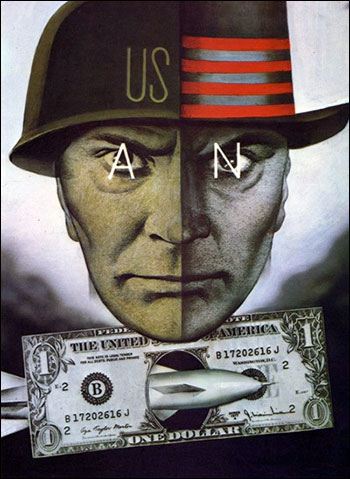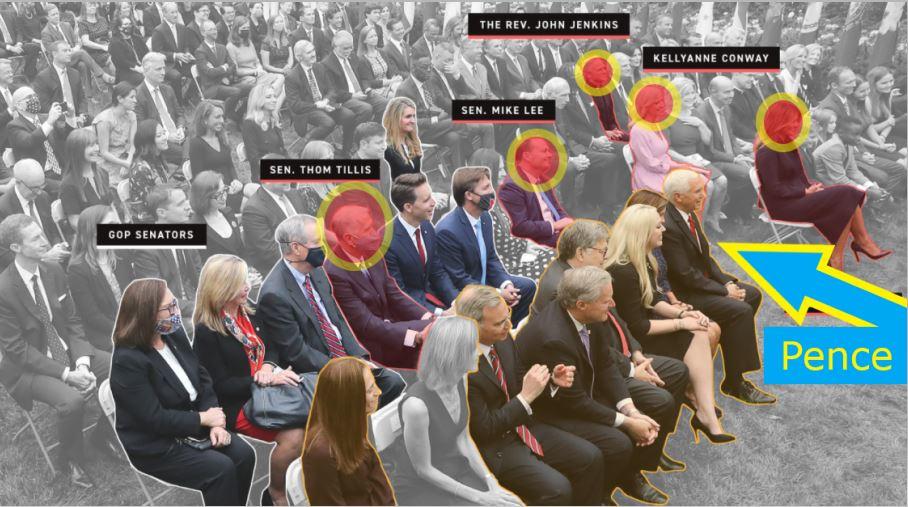Tim Kelly
Infowars.com
October 26, 2012
On January 17, 1961, President Dwight Eisenhower delivered a televised farewell address to the nation where he admonished the American people saying:
 We have been compelled to create a permanent armaments industry of vast proportions…we must not fail to comprehend its grave implications. In the councils of government, we must guard against the acquisition of unwarranted influence, whether sought or unsought, by the military-industrial complex. The potential for the disastrous rise of misplaced power exists and will persist. We must never let the weight of this combination endanger our liberties or democratic processes. We should take nothing for granted.
We have been compelled to create a permanent armaments industry of vast proportions…we must not fail to comprehend its grave implications. In the councils of government, we must guard against the acquisition of unwarranted influence, whether sought or unsought, by the military-industrial complex. The potential for the disastrous rise of misplaced power exists and will persist. We must never let the weight of this combination endanger our liberties or democratic processes. We should take nothing for granted.
Eisenhower was certainly not the first American to acknowledge the cash nexus between war and profit but he was perhaps the most prominent. His address channeled the conclusions of the Nye Committee, the U.S. Senate subcommittee chaired by Gerald Nye in the 1930’s that investigated the financial interests which underlay America’s entry into World War I.
During the interwar period (1918 to 1939), numerous books and articles were published arguing that arms manufacturers and certain banking interests, the so-called “Merchant’s of Death”, had conspired to draw the United States into war in order to protect and maximize their profits. Most famous of these was General Smedley Butler’s War is a Racket.
Murray Rothbard’s monograph Wall Street, Banks, and American Foreign Policy provided an excellent analysis of how a changing coalition of groups with vested interests in the U.S. government continually purchasing high levels of weaponry and waging wars had successfully manipulated U.S. foreign policy over the course of several decades.
Needless to say, the American people did not heed Ike’s warning. When Eisenhower left the White House in 1961, the Pentagon’s annual budget was around $50 billion. This was during the Cold War when the U.S. faced the combined powers of Soviet Russia and Red China. Today, the country has no credible geopolitical foes yet it is still is in the thrall of the military industrial complex, spending more than $700 billion per year on “defense.”
To provide a point of reference consider that the U.S. has only 5% of the world’s population yet its military budget constitutes 50% of the world’s total military expenditure, spending more on the military than the next 19 biggest spending nations combined.
Since World War II, the Pentagon has been the perennial big spender in Washington, and this has predictably created a powerful constituency interested in maintaining large military expenditures. Now in order too keep the money spigots flowing, an atmosphere of crisis has had to be maintained. This has required “scaring the hell out of the American people”, stirring up trouble abroad, and from to time to time fighting actual wars, albeit limited ones.
C. Wright Mills called this state of perpetual war “military metaphysics” – “the cast of mind that defines international reality as basically military.”
This vision was expanded upon in The Report from Iron Mountain. Published in 1967, the book was purported to be a leaked top secret government report written by a 15-member commission of scholars and experts, known as the “Special Study Group.” This group supposedly worked in an underground bunker called Iron Mountain; hence the book’s the title.
According to the report, the Special Study Group was established in 1963 to study the social and economic problems the United States would face if a lasting peace was achieved. The report concluded that even if lasting peace “could be achieved, it would certainly not be in the interests of society to achieve it.” It theorized that without war society would have no way to divert “collective aggression” and the very existence of the State itself would be threatened. It recommended institutions be created to promote militarism and the economic benefits of war and went so far as to suggest the U.S. government create enemies and encourage public hysteria over such things as alien invasions and environmental catastrophe.
The author, Leonard Lewin, asserted in 1972 that his book was only satire but its insights and observations led many believe it was a true expression of the power elite’s world view and an outline of their agenda. Harvard professor John K. Galbraith claimed in The Washington Post in 1973 that he had first hand knowledge that the book was an authentic U.S. government report because he had consulted in its production and been asked to keep it secret. He wrote:
As I would put my personal repute behind the authenticity of this document, so would I testify to the validity of its conclusions. My reservation relates only to the wisdom of releasing it to an obviously unconditioned public.
Though the reportmay have indeed been satire, it should be remembered that satire is based on reality. And the book did bring up points and topics that the people in the upper echelons of the American national security state were concerned with during the Cold War. Whatever the case, the “fiction” in Lewin’s book bore a disturbing resemblance to reality.
The report’s call for perpetual war as a means for promoting social cohesion and economic growth was very similar to the vision put forth the U.S. government’s National Security Memorandum No. 68. Moreover, the “enemy at the gates” meme and military Keynesianism have been the twin pillars of the Washington establishment since the late 1940’s.
Since 1945 the U.S. government has been either waging war or preparing for war. The undeclared wars in Korea, Vietnam were not fought to achieve victory. Indeed, in all of these wars American political and military leaders failed to articulate to the public a true military objective. Why?
While these wars had nothing to do with protecting the lives, liberties, and property of the American people, they did increase demand for the products of the military-industrial complex. In Korea (1950-1953) the U.S. government spent $341 billion and in Vietnam (1965-1975) the final bill to the taxpayer was $738 billion. Both of these wars resulted in the attrition and consumption of vast amounts of expensive military hardware, all of which had to be replaced thus ensuring the continuation of lucrative contracts between the Pentagon and “defense” contractors.
The Cold War itself could be seen as giant boondoggle intended to divert resources away from productive society and into the military industrial complex. Perhaps this is why throughout the four decade long superpower stand-off the military capacity of the Soviet Union was grossly exaggerated by the both the Pentagon and the CIA. Cui bono?
More perplexing from the Cold War perspective was the series of industrial and military technology transfers that occurred from the U.S. to the Soviet Union exposed by the Hoover Institute’s Anthony Sutton (1925 – 2002) . In his National Suicide: Military Aid to the Soviet Union, Sutton concluded the conflicts of the Cold War were “not fought to restrain communism” but rather to they were waged “to generate multibillion-dollar armaments contracts.”
Many have criticized Sutton’s conclusions as being too narrowly conspiratorial or simplistic and but his critics have failed to provide an alternative explanation for the copious levels of support the Soviet Union received from the West during the Cold War. Sutton appeared to have suffered the fate of so many revisionist historians. He was simply dismissed and ignored.
The late Col L. Fletcher Prouty concurred with Sutton, however. His views are noteworthy because he was the Pentagon’s liaison to the CIA and thus was a witness to many happenings within national security state in the early Cold War period. Fletcher wrote of the Cold War in his book, JFK: The CIA, Vietnam, and the Plot to Assassinate John F. Kennedy:
[The Cold War was] a very real killing war. Its battles loomed everywhere, and its dead were counted in the millions. More of the causalities were noncombatants than uniformed soldiers. It was the Secret War, the Invisible War. From the point of view of those in power, it was a welcome substitute. It consumed the population and the product of the munitions makers and was reasonably controllable on the side of the offense.
Now we have a so-called War on Terror which the U.S. government has been waging for over a decade and has reportedly cost the U.S. taxpayer $4 trillion. Supposedly this war is a necessary response to 9/11 but it is clear to anyone willing to look at the evidence those attacks were used as a pretext for an agenda mapped out years earlier by factions within the national security state and military industrial complex.
Critics of the War on Terror rightfully lament its costs and call for an end to it but many of them overlook the fact that the trillions of dollars “lost” in this phony war have found happy homes in the bank accounts of Lockheed Martin, Raytheon, General Electric, and many other military contracting firms . The war has also swelled the Pentagon’s budget which has grown from $277 billion in 2001 to $740 billion today. The U.S. government’s wars may be bleeding the country dry but they are making a few well-connected corporations and people very rich.
Much of these war profits are invested in campaign contributions, lobbying, outright bribery, sponsorship of various public affairs shows and mainstream news broadcasts, and maintaining a network of supposedly “independent” think thanks supporting the war agenda. The result is a perpetual war machine.
Many will argue that blaming America’s perpetual warfare state on corporate greed is too simplistic. After all, wars are complex geopolitical events that have multiple causes and involved multiple, overlapping agendas. But then again complex events often have simple causes. “Following the money” is a basic forensic technique in investigating any crime.
Perhaps it should be employed more often when investigating the crime of war.
The Emergency Election Sale is now live! Get 30% to 60% off our most popular products today!



